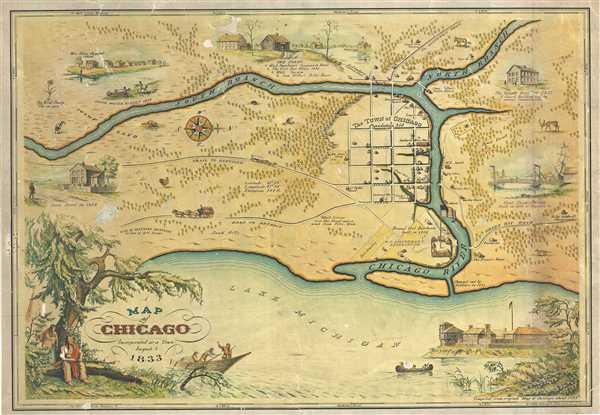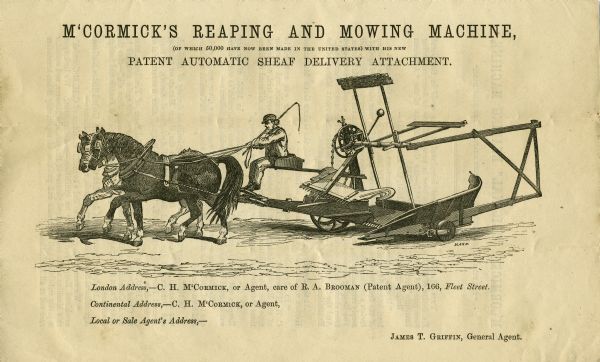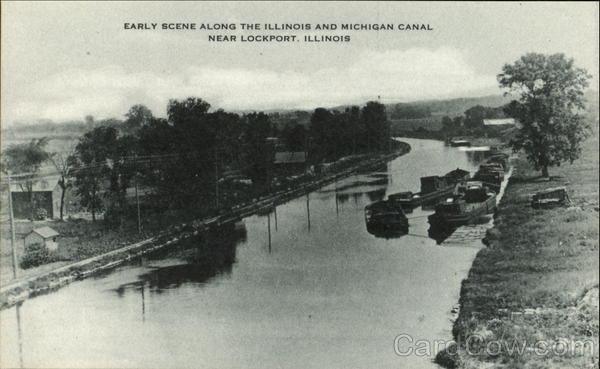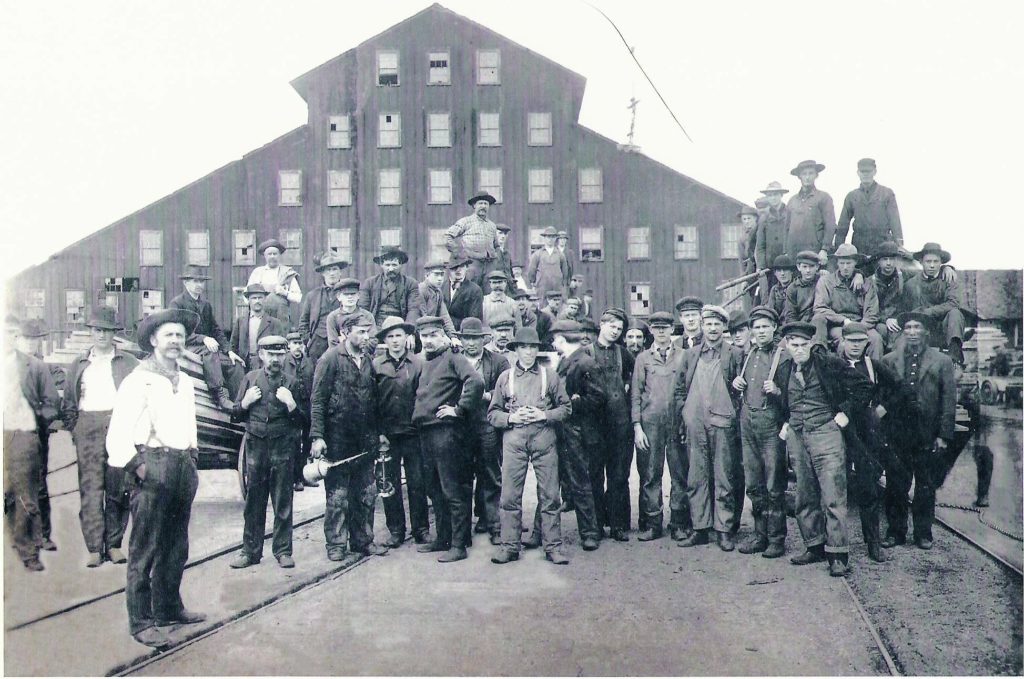| Fig. 1 - Bird's Eye View of Chicago in 2017 |
Chicago, a city known to many around the world did not gain its recognition in a matter of days. Nor did it earn it in a matter of years, in fact, Chicago has been developing since the 1600's. Chicago or "Chigagou", as it was called by the Native Americans who first inhabited the city and translates to the wild garlic place, was not an ideal place for living (Spinney, 5). Its marshy lands, long cold winters, and routine flooding hid the potential for the growth of the city. In 1673, Jacques Marquette, a Jesuit missionary, and Louis Joliet, a French explorer, while exploring the Mississippi River, came upon Chicago. These two men were the first non-natives to realize the potential of Chicago; it's connections to both Lake Michigan and the Mississippi River would've done wonders for trade, transport, and the overall development of the city. Unfortunately, when Joliet proposed the creation of a canal to connect Lake Michigan and the Mississippi River to Chicago, France denied it.
 |
| Fig. 2 - Map of Chicago from 1833 |
It was not until 1779 that Chicago had its first permanent resident, Jean Baptiste Pointe Du Sable (Spinney, 15). Sable, who's wife was a daughter of a Potawatomi chief, had a house built there. His house, which also functioned as a farm, trading post, and store, served as an indication that Chicago was growing. By 1803, Fort Dearborn, a significant military post in the upcoming war with the British and certain Native American tribes, was constructed. By 1814, a peace treaty was signed that ended the war with Britain, but also brought about the prejudice of all Native Americans by the Anglo-Americans in Chicago. By 1832, Chicago had built the first bridges over the Chicago River, the first jail, and the first public building, which was a pen to house all the livestock roaming Chicago. Then one year later, Chicago, whose population grew to 350, was officially named a town.
 |
| Fig. 3 - British brochure advertisement cover for McCormick's Reaper |
Chicago's population, by the year 1900, grew exponentially to 1.7 million (Spinney, 46). But it was not just the population that grew, Chicago as a city had also grew as a result of all the new people coming to Chicago. One of the first persons who helped develop Chicago was Cyrus McCormick. In 1847 McCormick opened his factory and began building his invention, the Reaper (Spinney, 52). The Reaper was a mechanical invention that would improve the efficiency of crop harvesting. Because farmers were able to harvest their grain faster, many farmers began growing wheat again. Wheat was considered a cash crop in the 19th century because not only was it difficult to grow, but if not harvested quickly, it would spoil, thus many farmers dared not take that risk. Farmers were now harvesting massive amounts of wheat, which by the year 1856, Chicago became known as the largest wheat market in the world (Spinney, 53). The massive amounts of bushels that farmers were producing forced Chicago merchants to perfect the grain elevator in the 1850's. The grain elevator was a machine that removed grain from ships or railroad cars, stored it in a warehouse, and then transferred it. The amount of grain being produced and sold also started up the Chicago Board of Trade between 1848-56. They were a group of grain traders that standardized the buying and selling of grain based on amount and quality. The Chicago Board of Trade created a form of currency called the grain receipt, which was redeemable for grain. The grain receipt soon gave rise to the grain futures market, where grain traders could invest in next year's crops. This would not only help farmers financially, but would give them an idea of what and how much to grow. Lastly, going back to McCormick, while his Reaper revolutionized harvesting, many farmers could not afford the $120 invention. McCormick knew this and introduced the use of credit. Farmers would pay an affordable fee upfront and then pay the rest after they sold their harvest.
 |
| Fig. 4 - Illinois and Michigan Canal |
It was more than the grain trade that helped the development of Chicago. One of the first biggest projects towards the development of Chicago was the construction of the Illinois and Michigan Canal in 1836 (Spinney, 48). The canal would reduce the difficulty and increase the amount of ships coming from and going to the eastern and western states. As a result, the amount of trade would also increase between Chicago, its farmers, and the eastern states. Farmers could now easily load their harvest onto ships, or have the grain elevators do it, versus having to travel back and forth and risk having their wagon get stuck in the mud roads. The ease with which ships were able to travel to and from Chicago also helped increase the city's population; between 1836-40, the city's population was around 4000 (Spinney, 42). Before the construction of the canal, in 1834, 150 houses and stores were constructed along the site of the canal, which in 1836, helped bring the total sales to $1 million (Spinney, 36). By 1848, when the construction of the canal was complete, shipments for corn increased eight-fold and lumber shipments doubled (Spinney, 48). Lastly, the construction of the canal also attracted thousands of immigrants, specifically Irish immigrants. Chicago did not have the man power to complete the canal and even if it did, the job was dangerous and paid very little, thus not many would take it. The Irish immigrants who came to Chicago because of the potato famine, were willing to take any job, regardless of risk. By 1850, 6000 Irish immigrants had come to the Chicago because of the canal (Spinney, 38).
| Fig. 5 - 1863 Map of the Galena Chicago Union Railroad |
While the canal made a significant impact to the development of Chicago regarding travel, trade, population, businesses, and so on, the construction of the railroads soon made the canal look outdated. Railroads vastly improved the speed at which goods, food, especially perishables, livestock, and people can get from one place to another. Railroads, unlike ships that couldn't operate during the winter, were able to operate year round. The massive size of the railroads, which by 1857 was 3000 miles of railroad tracks with nearly 100 trains passing through Chicago daily (Spinney, 51), would not only increase the amount of employment available in Chicago, but would also increase the population; from 1850-60, the population increased from 30,000 to 110,000 (Spinney, 51). The ever-growing railroads also put Chicago as the terminus, meaning that all trains going to and coming from the east or the west had to stop at Chicago. This would increase the amount of businesses opening up in Chicago, such as restaurants, hotels, stores, etc, to accommodate all the people passing through. The railroads not only help create businesses, but they also helped improve current businesses such as the McCormick's Reaper business, the size and weight of the Reaper made it difficult to transport to farmers, the meatpacking industry, faster transport for both livestock and pre-cut meats, the lumberyard industry and mail-order catalog business by being able to deliver to and from east and western states. Lastly, the railroads inspired George Pullman to create the Pullman sleeping car and eventually begin mass production of it in 1867 (Spinney, 94). The comfortability and luxury allowed commuters to enjoy their commute and would attract more to use it. It also gave many African Americans jobs and led to the creation of Pullman, Illinois (Spinney, 95).
 |
| Fig. 6 - 1876 Chicago Lumbering Company |
One business with which Chicago could not have developed was the lumberyard business. Lumber in the Midwest was scarce and badly needed by everyone for the construction of homes, barns, sidewalks, businesses, and many more structures. Chicago merchants were able to take advantage of the abundant supply of lumber in the upper states due to their vast amounts of virgin forests. Prior to the construction of the railroads, lumber was transported on barges via rivers. This method, however would not suffice in the winter time when rivers froze. Lumberyards heavily benefited from the railroads because they were able to ship lumber faster and to more places. The railroads helped the lumber industry in Chicago grow exponentially; in 1860, Chicago shipped 220 million board feet of lumber and by 1880, one billion board feet of lumber were shipped out (Spinney, 56). The lumber industry, besides providing farmers with the lumber needed to build barns, pens, and so on, also provided farmers with the opportunity to work as lumberjacks during their off-season.
| Fig. 7 - Chicago Union Stock Yards |
One industry that not only helped with the city's development, but was unique to Chicago was the meatpacking industry. Prior to the Civil War, Chicago had various competing stockyards that only sold live animals to butchers, which they in turn would produce the meat. It was the Civil War that would soon give Chicago the title of the largest meatpacking city (Spinney, 57). The Civil War brought upon an unprecedented demand for processed meat, which thanks to the railroads, Chicago was able to meet. In 1864, the Chicago Pork Packer's Association, along with nine of area's largest railroads, held a conference that discussed the inefficiency of Chicago's multiple stockyards. Their solution was to purchase a one-half-square-mile tract of land to construct the Union Stock Yards. The Union Stock Yards opened by 1865 and had 2,300 pens that required 100 tons of hay daily (Spinney, 58) The Union Stock Yards also had a 260 room hotel built for buyers and conveniently had the two meatpacking houses, Swift and Armour, built adjacent to it. The efficiency of the disassembly line was impressive to some and horrifying to others; up to 10,000 visitors came to see it daily (Spinney, 57). The Union Stock Yards, in 1892, employed 25,000 men (Spinney, 59). Initially, skilled German and Irish butchers were hired, but after a while, unskilled immigrants were used more due to their population and willingness to work for very little.
In 1870, Gustavus F. Swift created the refrigerated railroad car. Prior to Swift's car, meats shipped to the east were usually pickled or salted, but easterners preferred fresh meat. Swift's car was able to deliver fresh meat year round to easterners, but eastern butchers soon began spreading rumors that the meat was not fresh because their jobs were threatened. To retaliate, Armour and Swift began selling their meat to easterners at a very cheap price to convince them to try it and verify its freshness. The selling of meat for cheap in the east led to Armour figuring out how he can produce a profit from the 45% of the cattle that went unused; Armour was able to produce things like combs, glue, margarine, and many more and was able to produce a profit (Spinney, 61). The meat industry in Chicago grew so large that by 1893, one-fifth of the city's population was somehow connected to it (Spinney, 62).
 |
| Fig. 8 - Sears, Roebuck and Co. Mail-Order Catalog |
The last big business that developed in and helped develop Chicago was the mail-order catalog business. What was most significant about this business was that it connected rural and urban America. In 1872, Aaron Montgomery Ward opened the first retail-order business in America (Spinney, 63). Ward planned on opening his business up earlier, but the Great Chicago Fire of 1871 destroyed his entire inventory. Ward's middlemen bought consumer goods at low prices and sold them at higher prices. Many farmers became enraged by what he was doing and began protesting his business. Because farmers were Ward's main target as consumers, Ward decided to sell directly to farmers, thus cutting out the middlemen and changing farmers' opinions of him. Because Ward was selling goods at such low prices, the Chicago Tribune suspected his company of committing fraud. Ward proved his legitimacy by offering customers an unconditional money-back guarantee. When he first started out, Ward's catalog was a simple 8x12 sheet that listed 163 items. By the year 1900, Ward's catalog was 1200 pages long and listed 70,000 items. And also in that year, Ward had 2000 clerks working at his headquarters and had done business with two million rural customers (Spinney, 64).
Ward's success soon inspired Richard Sears and Alan Roebuck to establish their own competing mail-order catalog business, the Sears, Roebuck and Company in 1893. The advantage their catalog had over Ward's was that Sears would write text in the catalogs that persuaded customers into wanting to buy something that they never wanted or thought they didn't need (Spinney, 64). Sears also knew the importance of earning the confidence of rural customers and did all he could, like replacing a conductor's watch when it broke, to earn it. Sears growth soon became too much that it forced Ward to sell out. By 1906, Sears had moved his 9000 employees into a 40-acre building and was known as the largest retail business in the world.
 |
| Fig. 9 - 1898 Bird's Eye View of Chicago |
The development of Chicago has come a long way. Many inventions and innovations helped build Chicago to the great city it is today. And even still to this day, Chicago is always improving thanks to the effort put forth by all those who care deeply about this city.
Resources:
Spinney, Robert G., City of Big Shoulders: A History of Chicago, DeKalb, Northern Illinois University Press, 2000, Print.
Chicago: City of the Century: Mudhole to Metropolis, PBS, 2003, DVD.
Fig. 1: http://chicagoarchitecturebiennial.org/about/
Fig. 2: https://www.geographicus.com/P/AntiqueMap/MapOfChicago-conley-1933
Fig. 3: https://www.wisconsinhistory.org/Records/Image/IM64062
Fig. 4: https://www.cardcow.com/138929/early-scene-along-illinois-michigan-canal-lockport/
Fig. 5: http://mypresentpast.com/home/railroads/galena-and-chicago-union-railroad.html
Fig. 6: https://schs.cityofmanistique.org/chicago-lumbering-co-mill-fire-december-14-1907/
Fig. 7: http://www.chicagotribune.com/lifestyles/books/ct-prj-slaughterhouse-dominic-pacyga-chicago-stockyards-20151105-story.html
Fig. 8: https://saylordotorg.github.io/text_understanding-media-and-culture-an-introduction-to-mass-communication/s15-01-advertising.html
Fig. 9: https://www.cambooth.net/new-vintage-map-chicago-1898/


